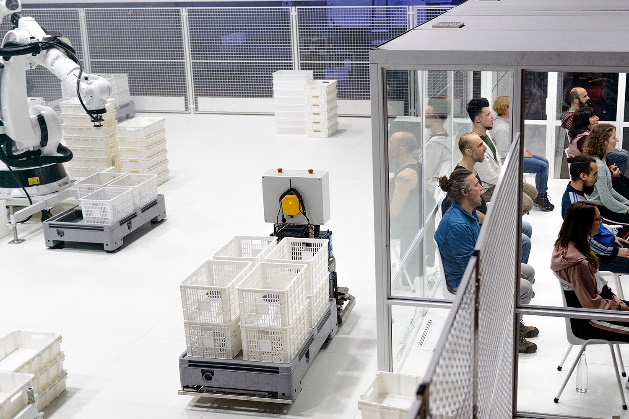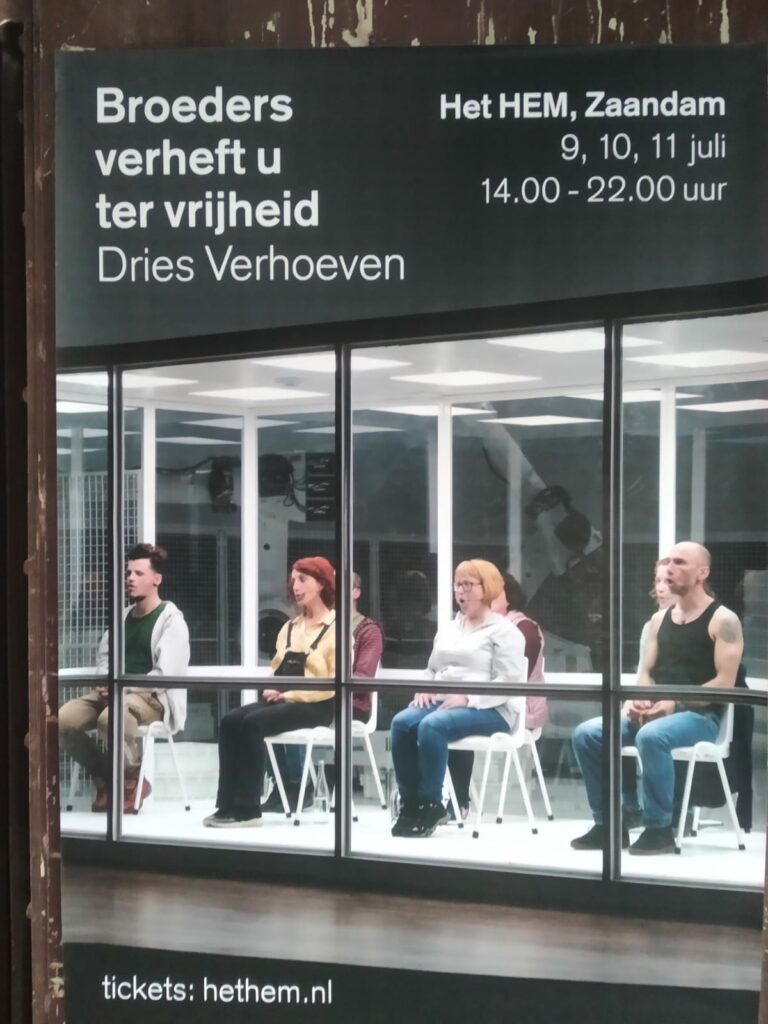
Flyer installation Zaandam – photo made by author

Broeders verheft u ter vrijheid – foto van website Dries Verhoeven, copyright Willem Popelier
THE FUTURE OF HUMAN LABOUR
The old ammunition factory on the Hemburgterrein in Zaandam forms the perfect theater for the mysterious and dystopian art installation by Dries Verhoeven. From 1896 until 2003 people produced weapons, artillery and munition for the Dutch army. With this history still in the atmosphere, the sound of an old ceremonious song, coming from the speaker of a white van, leads you to the entrance of the former factory. Walking through a cheerless and dark hallway, we find a glass room in which labourers sing Brothers, exalt thee to freedom! on loop. Behind the glass room, blinking robot arms move pallets, work that used to be done manually. After thirty minutes the alarm goes, the singers get 5 minutes to stretch their legs. Then it starts all over. Hours on end.
Dries Verhoeven wants the visitors to think about the purpose of working bodies in the contemporary world. Farmers replace Dutch workers with labourers from Central and Eastern Europe. At the same time, companies use algorithms, robots and other AI to get the largest profit margin. After all, computers work even harder than labour migrants.
Agriculture is also one of those sectors where machines take over parts of manual labour and people have to do the thankless tasks that cannot (yet) be done by robots. What does this mean for the thousands of seasonal labourers that come each year to work in the greenhouses of the Netherlands, or in the orchards in Belgium? Do their labour circumstances change? And how do labour migrants themselves feel about this? Do seasonal labourers change their plans for the future and start looking for other places or sectors to work and make three times the amount money they can make in their home country? This year I will try to answer these questions (and many more) by doing research in the Westland area (NL) and the Haspengouw region (BE). Dries Verhoeven and the eight Bulgarian performers who sang this labour anthem for hours and days on end without understanding the lyrics, give some preliminary food for thought.
De oude kogelfabriek op het Hemburgterrein in Zaandam vormt het perfecte theater voor de mysterieuze en dystopische installatie van Dries Verhoeven. Van 1895 tot 2003 werkten mensen hier aan de productie van vuurwapens, artillerie en munitie voor het Nederlandse leger. Met deze geschiedenis nog steeds voelbaar en zichtbaar op het terrein, leidt het geluid van plechtig gezang, afkomstig uit de luidspreker van een wit busje, je naar de ingang van de voormalige fabriek. Na een kale, donkere gang treffen we een glazen kamer waar werknemers achtereenvolgens Broeders, verheft u ter vrijheid! zingen. Op de achtergrond verplaatsen piepende robotarmen pallets, werk dat vroeger met de hand werd gedaan. Na dertig minuten gaat de zoemer af, krijgen de zangers 5 minuten pauze. Daarna begint het weer opnieuw. Uren achter elkaar.
Dries Verhoeven laat de bezoekers hiermee nadenken welk nut onze werkende lichamen tegenwoordig hebben. Tuinders vervangen Nederlandse werknemers met arbeiders uit Centraal– en Oost– Europa. Tegelijkertijd zoeken bedrijven met algoritmes, robots en andere AI die 24/7 werken naar de grootst mogelijke winstmarges. Computers werken immers nog harder dan arbeidsmigranten.
Ook in de landbouw nemen machines delen van het handwerk over en mensen hebben de ondankbare taak om klusjes over te nemen die (nog) niet door apparaten kunnen worden uitgevoerd. Wat betekent dat voor de duizenden seizoensarbeiders die ieder jaar naar de kassen in Nederland komen, en de fruitboomgaarden in België? Veranderen hun werkomstandigheden? En wat vinden arbeidsmigranten daar eigenlijk zelf van? Veranderen seizoensarbeiders hun toekomstplannen en zoeken zij andere plekken of sectoren om hard te werken en drie keer zoveel geld te verdienen als in hun herkomstland? Aankomend jaar probeer ik die (en nog veel meer) vragen te beantwoorden door onderzoek te doen in het Nederlandse Westland en het Belgische Haspengouw. Dries Verhoeven en de acht Bulgaarse performers die dit arbeidslied urenlang zongen zonder de tekst te begrijpen bieden alvast stof tot nadenken.
Wanneer het geluid van de bewegende machines niet de oorverdovende overhand heeft, komt het meerstemmige socialistische strijdlied als een geluidsmuur op je af. Kijkend in de ogen, ietwat ongemakkelijk, van een van de ‘arbeiders’ in de ogen, hoor je dat het inderdaad een meerstemmig lied is. Het verhaal van seizoensarbeid is alleen te begrijpen door te luisteren naar individuele stemmen en de verhalen die zij vertellen.
De ‘levende’ voorstellingen zijn helaas al voorbij, maar de ‘making of’ tentoonstelling is nog tot 15 augustus te bezoeken in West Den Haag.
